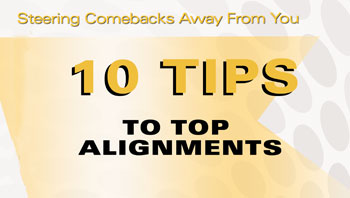 By Andrew Markel, Editor, BRAKE & FRONT END
By Andrew Markel, Editor, BRAKE & FRONT END
Tip No. 1: Don’t neglect the importance of the pre-alignment inspection.
The more thorough the prealignment inspection, the better your chances are of not overlooking something that might cause a comeback after the wheels have been aligned.
For starters, ride height should always be measured at all four corners of the vehicle, not just eyeballed. An inch or more of sag may not be apparent, but it can cause noticeable alignment problems.
Tip No. 2: Check the accuracy of your alignment equipment.
A simple but often overlooked cause of comebacks is alignment equipment that’s out of calibration. The cause may be something as simple as a rack that isn’t level or alignment heads that are out of adjustment — or something as serious as a mechanical or electronic glitch that produces inaccurate measurements.
Tip No. 3: Do a complete alignment.
Time is money, so the faster you get the job done the more money you make, right? Wrong. If you don’t do a good job because you’ve skipped things like checking toe-out on turns, ride height, SAI, caster (if nonadjustable), rear-wheel alignment (if nonadjustable), the condition of steering and suspension parts, etc., you may end up
having to do the job over again.
Tip No. 4: Don’t try to align worn parts.
To hold an accurate alignment, steering and suspension parts must be in good condition, which means no more play than allowed by the vehicle manufacturer. Always refer to a reference manual for the exact specs since acceptable ball-joint play can vary considerably from one application to another.
As parts wear, they get progressively looser and are less able to maintain accurate wheel alignment. If a tie-rod end or ball joint is borderline, it’s better to replace it now.
Tip No. 5: Don’t just set the toe and let it go.
If a front-wheel-drive car has no factory adjustments for camber or caster (Honda, for example), don’t just set the toe and let it go — always read all the angles. Why? Because if there’s a problem, a simple toe adjustment won’t fix it.
Many so-called “nonadjustable” suspensions can often be easily adjusted with the help of various kinds of aftermarket alignment aids. If you’re not already familiar with the use of camber/caster shims, caster wedges, offset bushings and the like, get some catalogs from the specialty alignment-product suppliers and find out what’s available.
Tip No. 6: Set to the factory-preferred specs, not rule-of-thumb specs.
There are no such things as “rule-of-thumb” specs when it comes to wheel alignment. What works on one vehicle may or may not work on another. Front-wheel-drive cars usually require different toe settings than rear-wheel-drive cars. Vehicle weight, chassis design, chassis loading, tire size, driveline configuration and intended use all affect wheel-alignment settings that the vehicle
manufacturer develops for the vehicle.
Tip No. 7: Compensate for how the vehicle is driven and used.
Vehicle loading can have a very pronounced effect on wheel alignment. If a vehicle that’s normally loaded with passengers or cargo is aligned while empty, the tires will likely exhibit rapid wear because they won’t be running true when the vehicle is driven while carrying its normal operating load.
Tip No. 8: Align all four wheels, not just the ones up front.
Four-wheel alignment has become much more commonplace in recent years, but there are still those who won’t align all four wheels because the customer doesn’t want to pay “extra” for a four-wheel alignment. This may be more of a marketing problem than a technical one, but the
public needs to be educated that the rear wheels have just as much influence on where a vehicle goes as the ones up front.
Tip No. 9: Make sure the steering wheel is centered.
One of the leading causes of alignment comebacks is a steering wheel that’s off-center. Tire wear takes a while to catch up with a customer if the alignment isn’t on the mark, but an off-center steering wheel will be noticed immediately.
Tip No. 10: Test drive the vehicle before it’s returned to the customer.
A simple test drive can reveal a lot of problems that might have been otherwise overlooked. Sure, test drives take time, but so do comebacks. Think of it as a final quality-control check.











